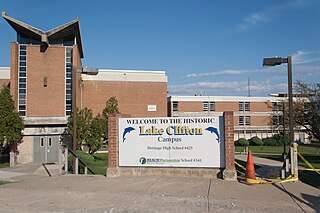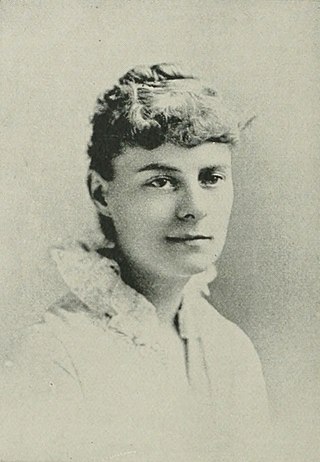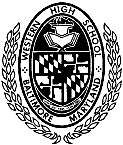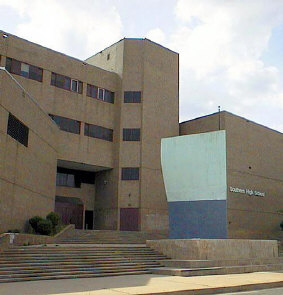
Lake Clifton Eastern High School (LCEHS) was a public high school closed in 2005, located in the Clifton Park area of northeast Baltimore, Maryland. Originally called Lake Clifton High School (LCHS), although it was commonly known as Lake High School or Lake Clifton, it is now called the Lake Clifton Campus (LCC).

Baltimore City College, known colloquially as City,City College, and B.C.C., is a college preparatory school with a liberal arts focus and selective admissions criteria located in Baltimore, Maryland. Opened in October 1839, B.C.C. is the third-oldest active public high school in the United States. City College is a public exam school and an International Baccalaureate World School at which students in the ninth and tenth grades participate in the IB Middle Years Programme while students in the eleventh and twelfth grades participate in the IB Diploma Programme.

The Institute of Notre Dame was a private Catholic all-girls high school located in Baltimore, Maryland. After 173 years, the school closed on June 30, 2020.

Friends School of Baltimore is a private Quaker school in Baltimore, serving students in pre-kindergarten through 12th grade.
The Maryland Interscholastic Athletic Association (M.I.A.A.) is a boys' sports conference for private high schools generally located in the Baltimore metropolitan area but extending to various other regions, including the state's mostly rural Eastern Shore. The M.I.A.A. has 27 member schools and offers competition in 17 sports. In most sports, it offers multiple levels of competition, including Varsity, Junior Varsity, and Freshmen-Sophomore teams, and the conference is broken down by separate leagues in each. In addition, members are sorted in accordance to continual performance; categories include 'A', 'B', or 'C' Conferences. Teams of the Association (League) may move up or down according to their performance spanning over the course of a year or so to maintain the competition at appropriate levels. Such levels vary for each sport; a school with a "B-Conference" lacrosse team can have an "A-Conference" soccer team: it all depends on the athletic performance of that particular sport.

Lizette Woodworth Reese was an American poet and teacher. Born in Maryland, she taught English for almost five decades in the schools of Baltimore. Though Reese was successful in prose as well as in poetry, the latter was her forte; she was named Poet Laureate of Maryland in 1931.

Western High School is the oldest public all-girls high school remaining in the United States. It is the third-oldest public high school in the state of Maryland and part of the Baltimore City Public Schools. Western High was named a "National Blue Ribbon School" of Excellence by the U.S. Department of Education in 2009 and a "Silver Medal High School" by the news magazine U.S. News & World Report in 2012.

Frederick Douglass High School, established in 1883, is an American public high school in the Baltimore City Public Schools district. Originally named the Colored High and Training School, Douglass is the second-oldest U.S. high school created specifically for African American students. Prior to desegregation, Douglass and Paul Laurence Dunbar High School were the only two high schools in Baltimore that admitted African-American students, with Douglass serving students from West Baltimore and Dunbar serving students from East Baltimore.

Heritage High School was a public high school located in the northeast area known as Clifton Park of Baltimore, Maryland, United States. It served Baltimore City high schoolers from 2004 to 2015.

Waverly is a neighborhood in the north central area of Baltimore, Maryland, located to the north of the adjacent same neighborhood called Better Waverly and west of Ednor Gardens-Lakeside, north and east of Charles Village west of the area of Coldstream-Homestead-Montebello neighborhoods, along with the campus of the former red brick H-shaped building for Eastern High School (1938–1984), facing north towards 33rd Street, now renovated since the 1990s into offices for The Johns Hopkins University, a mile to the west. Adjacent to the east of the Eastern High/Johns Hopkins campus is the landmark tree-shaded campus of The Baltimore City College, at 33rd Street and The Alameda. The College is a massive stone structure with a 150-foot bell tower visible for miles, nicknamed "The Castle on the Hill", constructed 1926–1928 of Collegiate Gothic architecture on one of the highest hills in the city, "Collegian Hill", with the downtown skyline visible to the south. City College is the third oldest public high school in America, founded 1839 in downtown has been through eight different sites in its 179 years of history and five major buildings, each were architectural landmarks in their times. From its beginnings, until 1979, it was a single sex secondary school for boys in the Baltimore City Public Schools, when it co-educated admitting young women. These three major institutions and their sports events dominated the east side of Waverly/Better Waverly for nine decades.

The history of The Baltimore City College began in March 1839, when the City Council of Baltimore, Maryland, United States, passed a resolution mandating the creation of a male high school with a focus on the study of English and classical literature. "The High School" was opened later in the same year on October 20, with 46 pupils under the direction of Professor Nathan C. Brooks,(1809-1898), a local noted classical educator and poet, who became the first principal of a new type of higher institution in the developing public education system in the city begun in 1829. It is now considered to be the third oldest public high school / secondary school in the nation. In 1850, the Baltimore City Council granted the school, then known as the "Central High School of Baltimore", the authority to present its graduates with certificates of completion. An effort to expand that academic power and allow the then named "Central High School of Baltimore" to confer Bachelor of Arts degrees began following the Civil War in 1865, and continued the following year with the renaming of the institution as "The Baltimore City College", which it still holds to this day, with also the retitling of its chief academic officer from "principal" to "president", along with an increase in the number of years of its course of study and the expansion of its courses. However, despite this early elevation effort, it ended at that brief period unsuccessfully in 1869, although the B.C.C. continued for a number of years as a hybrid public high school and early form of junior college which did not fully appear in America in different form until the beginning of the 20th century. Very often the elaborate decorative fancy engraved graduation diploma from the B.C.C. in the late 19th and early 20th centuries was accepted by many other colleges and universities entitling City graduates to enter upper-division schools at the sophomore year,.

The Coldstream-Homestead-Montebello community, often abbreviated to C-H-M, is a neighborhood in northeastern Baltimore, Maryland. A portion of the neighborhood has been listed on the National Register of Historic Places as the Coldstream Homestead Montebello Historic District, recognized for the development of a more suburban style of rowhouses.

Edward Livingston Palmer Jr. was an American architect from Baltimore, Maryland, credited with the design and development of several planned neighborhoods such as Homeland, Roland Park, Guilford, Wawaset Park, and the design of many buildings within Dundalk, Maryland, which were created specifically for the workers of Bethlehem Steel

Clifton Park is a public urban park and national historic district located between the Coldstream-Homestead-Montebello and Waverly neighborhoods to the west and the Belair-Edison, Lauraville, Hamilton communities to the north in the northeast section of Baltimore, Maryland, United States. It is roughly bordered by Erdman Avenue to the northeast, Sinclair Lane to the south, Harford Road to the northwest and Belair Road to the southeast. The eighteen-hole Clifton Park Golf Course, which is the site of the annual Clifton Park Golf Tournament, occupies the north side of the park.

Southern High School was a former public secondary school on Warren Avenue between William Street to the west and Riverside Avenue to the east, in the Federal Hill neighborhood of the northern side of the larger old South Baltimore community on the Whetstone Point peninsula. With historic Fort McHenry from the War of 1812 (1812-1815), to the southeast at the point itself and additional residential areas surrounding the high school in tightly packed rowhouses and streets known as Locust Point and Riverside to the south and southeast along with the restored Otterbein and Sharp-Leadenhall neighborhoods to the west, also just south of the downtown central business district and famed "Inner Harbor" of the City of Baltimore, in Maryland.
33rd Street, originally called Thirty-third Street Boulevard, is a long, wide, east–west parkway with a broad tree-shaded median strip. It is surrounded by 1920s-era "Daylight-styled" row houses with porches and small front yards. It was designed by the Frederick Law Olmsted Brothers firm, as part of their Baltimore Plan of 1904 and 1921 for establishing stream valley parks and connecting boulevards.

Eastern Female High School, also known as Public School No. 116, is a historic female high school located on the southeast corner of the 200 block of North Aisquith Street and Orleans Street, in the old Jonestown / Old Town neighborhoods, east of Downtown Baltimore and now adjacent to the recently redeveloped Pleasant View Gardens housing project / neighborhood of Baltimore, Maryland, United States. It was built in 1869-1870 and is typical of the Italian Villa mode of late 19th-century architecture. It was dedicated in a large ceremony with speeches later published in a printed phamplet and attending crowds in early 1870. Old Eastern High is a two-story brick structure that features a square plan, three corner towers, and elaborate bracketing cornices, with a similar wood decorated porch/portico over front entrance on its west side facing Aisquith Street.

Baltimore City Public Schools (BCPS), also referred to as Baltimore City Public School System (BCPSS) or City Schools, is a public school district in the city of Baltimore, state of Maryland, United States. It serves the youth of Baltimore City. Traditionally, however, the Baltimore City Public Schools system has not referred to itself as a "district," as the operation of the schools was synonymous with the city of Baltimore. Its headquarters are located on 200 East North Avenue at North Calvert Street in the Dr. Alice G. Pinderhughes Administration Building.

Baltimore Heritage is an American nonprofit historic-preservation organization headquartered in Baltimore, Maryland.

The Homewood Campus is the main academic and administrative center of the Johns Hopkins University. It is located at 3400 North Charles Street in Baltimore, Maryland. It houses the two major undergraduate schools: the Zanvyl Krieger School of Arts and Sciences and the Whiting School of Engineering.





















